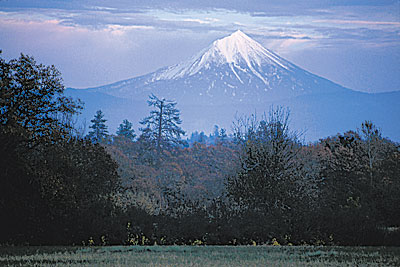|
Climbing Mount McLoughlin a test of ourselves
 |
Lee Webb/US Forest Service
Mount McLoughlin is the highest of all peaks in Southern Oregon. |
What exactly drives people to risk life and limb climbing mountains? I decided to find out during a hike up Mount McLoughlin, Southern Oregon’s highest summit, during a trip in which I met some unusual climbers. o o o oBy Zach Urness of the Daily CourierTruth be told, I’ve always been a little puzzled with humanity’s need to climb mountains.First off, it’s hard. Scrambling up steep boulder-strewn cliffs until your legs feel like tapioca pudding, or pulling yourself up the face of a giant crest on ropes and carabiners is, to say the least, tough. Second, there’s really no tangible reward. It’s not like there’s a leprechaun with a sack full of gold coins waiting when you reach the summit. When British explorer George Mallory was asked why he wanted to climb Mount Everest, he famously quipped, “Because it’s there.” But that’s too simplistic. “Because it’s there,” doesn’t explain why 91 climbers died on Everest between 1981 and 2002 or why 11 recently died on K-2 in Pakistan. Yet people continue to attempt both mountains in droves. To try and gain some perspective, I decided to climb Mount McLoughlin, which at 9,495 feet is Southern Oregon’s tallest peak. Labor Day seemed an appropriate date for this adventure, considering I’d be laboring nearly 4,000 feet upward on a trail of 11 miles round-trip. I couldn’t have picked a more perfect day for the hike. Fresh fall air wrapped itself around the Shasta red fir trees as I hiked, and chilly streaks of sunlight dappled the trail during an easy 2.5-mile start. After around four miles, I passed the timberline and stopped near a spur at 8,200 feet. The trail continued along a craggy ridgeline that shoots upward 1,300 feet in just 1.5 miles over dusty boulders and a mix of sand and pebbles to the summit. Now the mountain climbing would begin. As I moved slowly upward, I came across something that blew me away. Two silver haired women wearing floppy fishing hats and hiking with ski poles were chuckling in front of me, moving slowly up the mountain. I was shocked. They both looked old enough to be my grandmother. I walked up to the woman in front and introduced myself. Their names were Judy and Dana, and they were trying for the third time to make it to the summit. “I’m going to turn 70 next month, so I thought I better get this dang mountain out of the way first,” Judy said with a laugh. “The weather has always turned on us here. I hope today is the day.” “I hope so, too,” I said, while at the same time thinking, “no darn way.” I said farewell to Judy and Dana and continued upward. My feet crunched as I climbed over the dry, sun-baked ground. Pumice rocks of blues and reds along with other volcanic rock were strewn about along the trail. The next group I came upon had the look of professionals. They all had new-looking climbing gear and were perusing topographical maps. I started chatting with a friendly looking guy named John, who explained that they were from a group called the Mazamas from Portland, and that they climbed mountains from Washington to California. “So why do you do it?” I asked him. “I guess I just love getting to the top,” he said. “Seeing the view, you know, bagging another summit.” Then he looked at me and asked, “Why are you doing it?” “To impress the ladies,” I joked. He laughed. “How’s that working out for you?” “Not as well as you’d think,” I said. I continued upward along the ridgeline. In some places the trail came close to the edge. I looked down at what I estimated as more than a 1,000-foot drop into a stone ocean below. Then going became progressively tougher. I lost the trail altogether toward the top and simply began climbing straight up over giant rocks and scrambling atop loose gravel. I finally reached the summit, which was designated by a big wooden pole, sticking straight up in the rock. The panoramic view was stunning. The sheer breadth of pine trees looked like a giant green carpet coating land below, undulating unevenly as the surrounding mountains rise and fall. Four Mile Lake, Squaw Lake and Lake of the Woods appeared as puddles, and the milky blue of the Klamath Basin shone in the background. Every major peak was visible on this clear day — Mount Thielsen, South Sister, Mount Shasta and finally the Siskiyous and Rogue Valley in the southwest. At long last, I decided to head downward. But as I steeped over the ridgecrest of the summit, I saw a familiar sight. Less than a hundred feet below me, two floppy fishing hats were bobbing along, slowly, but nearly to the top. “Huulloo,” Judy said. “Bet you didn’t expect to see a pair of old ladies up here!” I was impressed. I have plenty friends in their 20s who wouldn’t stand a chance of making the summit. Yet here were two elderly ladies that looked as though they should be playing shuffleboard, canasta and bragging about their grandkids instead of standing on the doorstep of Southern Oregon’s highest point. “So you made on your third try,” I said. “Why’d you keep at it?” Judy looked at me quizzically. “Who knows?” she asked coyly. “Just thought we’d go out for a stroll. Maybe climb a mountain.” There are plenty of reasons people climb mountains. The view from the top, the bragging rights or for the workout. But I think the main reason we climb mountains is to prove to ourselves that we can ... to test our strength against the cold, unforgiving stone.
| 




